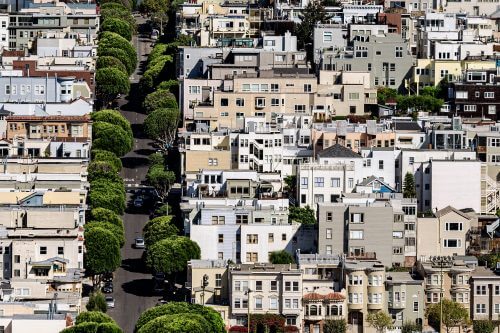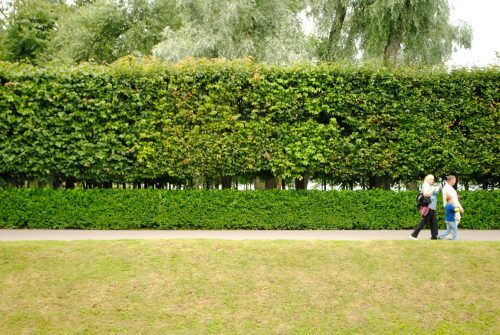A new study has found that hedges and shrubs are much more effective than trees in absorbing air pollution within the city. Should the big cities in Israel re-plan the vegetation on their streets?

By Shahar Shluh, Zveta, Science and Environment News Agency
Among those who do not deny science, there is no debate about this that trees make a huge contribution to reducing air pollution and, as a result, also to reducing global warming. However, a new study suggests that for the benefit of clean air in the lungs of city dwellers, it is worth focusing less on tall trees and more on hedges.
scientific article Written under the leadership of Prof. Prashant Kumar, head of the Center for Air Quality and Health at the University of Surrey in the UK, claims that trees are indeed good at absorbing pollution, but mainly in open areas. On the other hand, bushes of the species that are planted to create a hedge can more effectively reduce the direct exposure of humans to dangerous pollutants. In addition, it was found in a study that in an urban landscape of the "canyon street" type - a street where the height of the buildings on both sides is significantly higher than its width - trees are not effective, but they are very effective near urban roads in an open urban landscape.
between the sidewalk and the road
According to Kumar, local authorities should try to plant low bushes between sidewalks for pedestrians and the road, if the width of the sidewalk allows it. The research by Kumar and his partners in the European Union and the United States is now focused on trying to find out which plants are the best for fighting air pollution and what is the ideal height of hedges to be used for this purpose.
Plants assimilate carbon dioxide and turn it into sugar in the process of photosynthesis, and in this sense every plant is useful for reducing air pollution and reducing the accumulation of the greenhouse gas carbon dioxide in the atmosphere. But while photosynthesis takes place only during the daylight hours, the bushes of the animal settings offer another and different service that takes place 24 hours a day. If you poke around a little in this type of bush, you can find dust, soot and other pollutants trapped in the dense foliage. In other words, what the bushes offer us is mechanical filtration, and the denser the bush is and is completely covered in foliage all year round (an evergreen bush), the more its filtering ability increases. Another advantage of vegetation along roads is Noise suppression. In studies in the field of acoustics, it was found that trees also dampen noise, but considering the density of vegetation required, in this case too, bushes are more suitable for the urban space.
According to Kumar, one thing is certain about the vegetation in the city: "The best thing about hedges is that they are exactly at the height of the exhaust," he told BBC News. "The concentration of emissions from vehicles decreases rapidly as you move away from the road, so any hedge, which functions as an obstacle that slows down the air flow and captures the pollutants in the leaves, may provide people at home with improved protection."
And what is happening in Israel, where the streets are narrow, the cars are parked on the sidewalks in many cases and on the sunny days the pedestrians are lost in the shade? Prof. David Brodai from the Environmental Engineering, Water and Agriculture Unit in the Faculty of Engineering at the Technion, whose research deals with air pollution and exposure to it, explains that trees in the city are a blessing and a thorn in its side. On the one hand, trees have many advantages in the urban space: they contribute shade that may lead to energy savings in spending on air conditioning, they create a green area that may change the nature of traffic and attract pedestrians and cyclists instead of using vehicles, and they reduce air pollution.

On the other hand, trees can have disadvantages. "Trees can reduce the dispersion of pollutants and thus increase their concentration near the source, which is the ground, i.e. near people - pedestrians, drivers, etc.," Brodai explains. It is precisely in this place that the advantages of the animal enclosures from Kumar's research are revealed, even in our crowded cities. The animal fences do not leave the pollution near the road like the tree canopies do, but absorb it.
Add vegetation paths
Brodai is optimistic about the challenging urban planning in Israel: "Already today we see 'architectural' changes in the structure of the streets in the city - pedestrian crossings, narrow roads, public transport routes, areas where the entry of vehicles is prohibited, areas where parking is limited, toll roads and toll lanes, bicycle lanes, paths for pedestrians, etc. That's why I don't see why 'vegetation paths' can't be added to the urban landscape. It seems natural, simple, and positive to me." According to Brodai, the paths of vegetation, which will be created by dedicated gardening, will save lives because they will further distance motorized transport from people - cars will not just walk on the sidewalk in an accident, pedestrians will not cross the road at any point they want.
"Vegetation paths will allow for a combination of saving trees and a tangled hedge near the ground," he explains. "The narrowing of the roads should reduce the traffic congestion caused by private cars because the journey will be slow, there will be no parking spaces, and cars will not be able to enter everywhere. Reducing the number of vehicles and encouraging the use of more efficient vehicles, electric or hybrid, should reduce emissions at ground level, so that the trees will not cause an increase in the concentration of pollutants." In other words, live fences, and plants in general, have a lot to offer the city's residents, but changes in traffic will intensify the positive effect and will also mean that we can continue to enjoy tall trees without fear of trapping pollution at street level.
Brodai believes that there is a need for a holistic solution that will include "changes in urban transportation through positive incentives for public transportation (good, not like what exists today, but one that gets the citizen where he needs to be at a reasonable time, at a reasonable price and comfortably), negative incentives for private transportation, changes in the architectural plan of the city that will contribute to the above-mentioned changes, planting plants that will support the transition to non-motorized means of transportation, including walking, changes in the variety of small businesses in the city and in the neighborhood so that local services are provided within walking distance of the house - food products, a clinic, a hair salon, places of recreation, playgrounds and sports, and more".
Animal enclosures are not alien to the Israeli urban landscape. Around old houses you can still see green walls and trimmed arches above the entrance gate to the yard. When these fences are high enough and when cars and cans don't cover the sidewalk, they provide pleasant shade at least during part of the day. Maybe it's time to bring back a green crown to its former glory and enjoy both the aesthetic advantage and the health advantage they offer.

5 תגובות
shadow…
Trees are shade, without shade you can't walk around the street, pollution is not the most important thing
And perhaps instead of finding solutions to the problem of pollution, we should solve the pollution of vehicles - differential taxes on vehicles according to their level of pollution
It seems to me that everything is a dream in aspemia. The way the cities are planned in Israel, it is not possible to add hedges (anyone remember this term?) on 99% of the streets. Perhaps on Ibn Gvirol Street in Tel Aviv, which is perhaps the only street in Israel built with shade in mind, there is room to add a hedge. (Who remembers who was the original architect of Ibn Gabirol?). But recently the city has been busy adding bike lanes, so forget shade, trees and hedges.
Trees have an important advantage in a hot country. The Avenue of Trees on the way to the Culture Hall on Yom Hamsin is the difference between a pleasant place and a pleasant one. shadow. Another advantage, perhaps: emission of oxygen into the atmosphere. The solution should be from the two.
People need to be incentivized...
For example, anyone who sets up a green roof garden will have a discount on property taxes and the like, as in several European countries.
It certainly reduces air pollution and also saves energy for cooling the houses